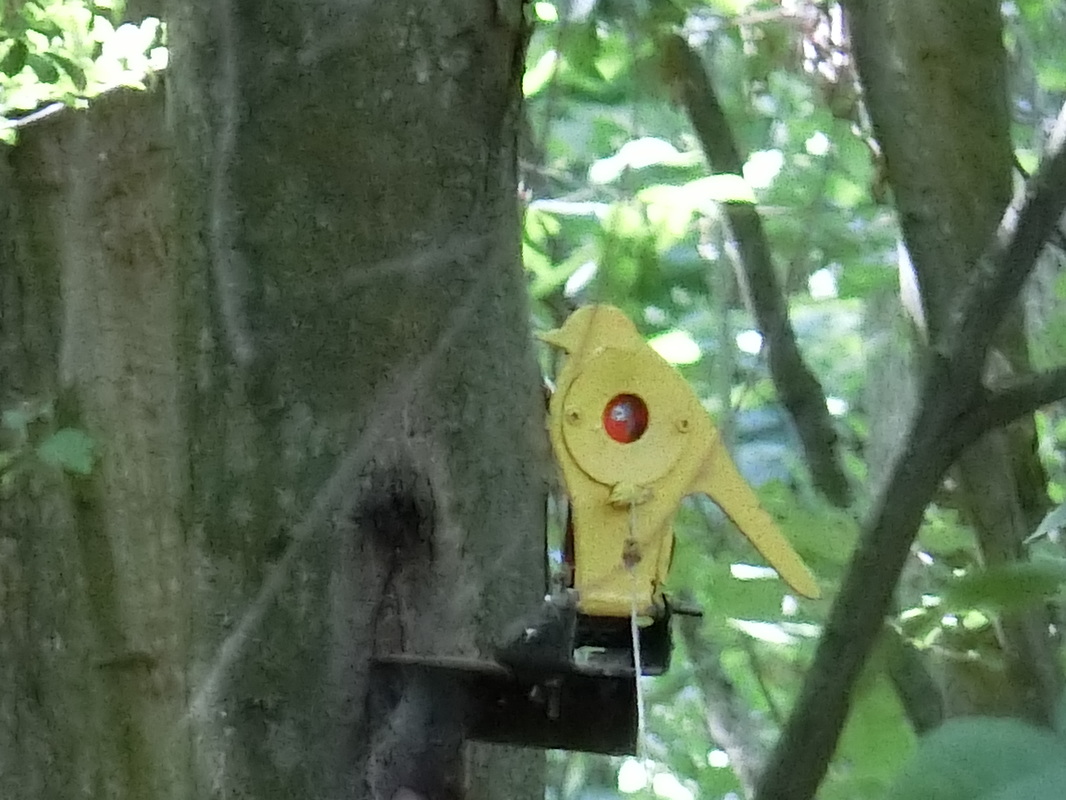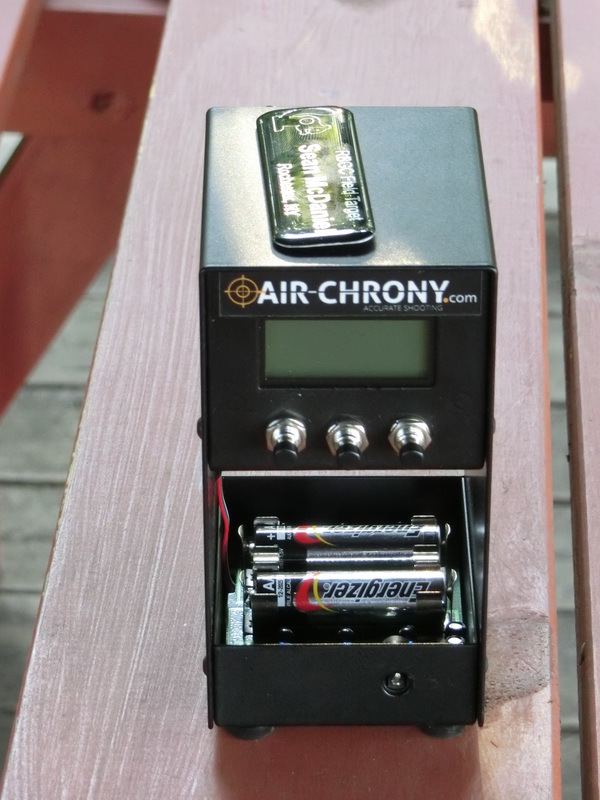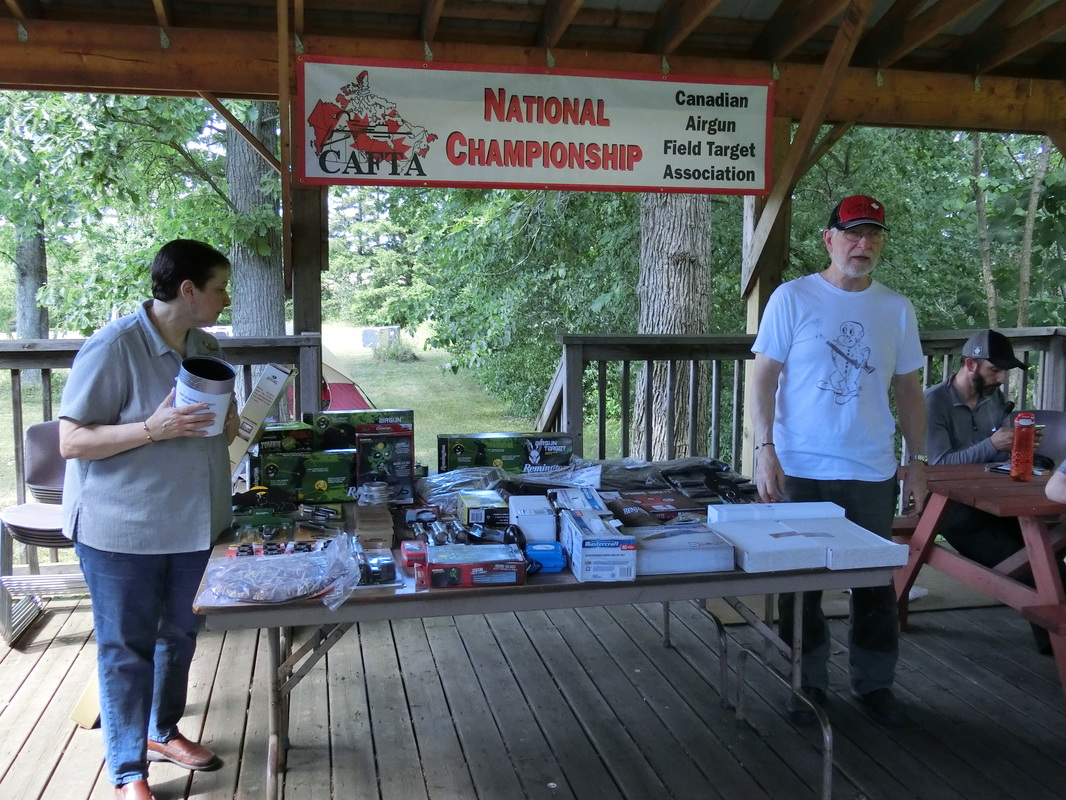For years, Veronika and I have regarded Tim McSweyn as the leading figure in Canadian FT, and have considered him a friend. The second will never change, but time has come for Tim to pass the baton on in this relay race that life is.
Family conditions present themselves so that Tim can live now closer to his grandkids and no one can blame him for taking the opportunity to move.
And, now that he moves he will be able to go to FT Matches without actually having to work as hard. ;-)
For over 15 years Tim has held or co-held the Canadian Nationals, now will be the time for the younger crew: Dennis Eden, Tom Peretti, George Harde, Dean, and all the others at Port Colborne, Don et al at Burlington, Brian Milne, Dave Bartlett and the others at Ottawa, and other Clubs in Canada.
Hopefully, Canadian FT will continue to flourish with more Clubs springing up here and there.
Hopefully, the Canadian Nationals will start to rotate to other Clubs. Not because Port Colborne is not one of the best places to shoot FT, but because it is in the long term interest of the sport to spread the opportunity, and the burden.
So, let this blog entry be dedicated to one of the best persons I know that is also an avid FT shooter with both S-P's and PCP's and an outstanding MD:
After we shot the "Crosman Shoot", we headed to Canada.
We made one stop before reaching Niagara Falls, and in here I must confess that I will date myself for saying that for many years in my childhood I had dreamt of visiting a carrousel factory, and now the opportunity came in Upstate NY, in Tonawanda there is the Herschell Carrousel museum, an old factory with links to some very interesting industrial history.
After a tour of the museum and learning some interesting facts we got a ride in a historic Carrousel.
Interesting how even in those times, Carrousels were being tailored to local tastes. Here was a man that thought globally and acted locally way before his time.
The falls were as amazing as I remembered them from 50 years ago when we visited with my father.
We had an excellent meal and then we headed to the Border Crossing point. Not without some trepidation, this thing about air rifles being firearms when they exceed 500 fps and 5.5 ft-lbs was a little scary.
It is the same in Germany, but we arrived in Germany with solid police-issued documents stating we were allowed in. Not so in Canada and that was either a very good sign or a very bad one.
Glad to report that it is a good one. The RCMP elements at the Niagara Falls border were VERY formal about everything. They checked the car inside and out and requested help to open the case (it wasn't locked but the German clasps are somewhat peculiar). They also made a pass with the dog. Very thorough.
Once the "Mountie" had finished his inspection, I got turned into the capable hands of the inside guys.
I addressed a girl at the counter, but it happened that she was in training and she needed the help of an officer.
By the time the officer came to, I was a little impatient. Veronika and Daniel were out in 90+° heat, not allowed to board the car and the AC.
The officer must have seen my face, or perhaps it was my charming smile and sly remark "I was told I had to pay something here" that moved him into faster action :-) .
He apologized about the fact that they do not get many guns through that border point, and it was true, the last number issued from the registration book was dated May 2016. So, in almost two months no one had passed by registering a firearm for entry into Canada at that border crossing, one of the busiest.
Interesting.
And that was another interesting point. They do not issue a permit. What they issue is a registration number and proof, that then allows you to be in possession of the firearm while in Canada.
It does not matter if you are bringing in an airgun for FT competition or if you are bringing in a 0.375" HH Magnun to hunt Kodiaks, both are treated exactly the same. I am sure they would ask a ton more questions for a 0.375" HH, like hunting outfitter, area of permit, hunting license, US hunter safety course proof and other things but, paperwise, they are the same.
One thing I liked is that they told me in no uncertain terms that I was responsible for the firearm and that if it got stolen, it would still be my responsibility. Sort of what happens in New Zealand. I think it is great common sense.
Once we got the registration paid and we were boarding our car I found out Veronika was furious because the guy opened EVERYTHING and did not bother to close ANYTHING! LOL!
I just took is as an SOP and we continued on our way to Hamilton.
Now, even in Canada, I got quizzing looks when I said we were going to Hamilton. ¿What is there in Hamilton?
Well, several things, not the least of which is the fact that you are within driving distance (1 hr) of Toronto without having to spend the day & night in one of the most expensive cities in Canada. BUT, apart from that, there were three things I wanted to see, and let me give you a first hint:
This is Veronika and Daniel sitting in the cabin of a fighter airplane in the process of restoration:
Well, they have an excellent collection of fully operational WWII airplanes, among them the AVRO Lancaster, the plane that was instrumental in the bombing run of the Ruhr valley dams with a reverse spinning bomb designed to hit the concrete wall and sink halfway to the bottom before exploding.
Such a strange concept that makes me sure to think that the inventor, Barnes Wallis, must have been an airgunner. :-P
They also have a B25 Mitchell, famous not only because it was the plane used in Dolittle's Tokyo raid, being the only time that a full flight of semi-heavy bombers were launched from a Carrier.
It also happens that the B-25's were the planes lent by the US to Mexico when Mexico entered WWII contributing the "Escuadrón 201".
The other thing I wanted Veronika to see was Dundurn Castle.
She is a big fan of "Downton Abbey" and "Upstairs/Downstairs" types of films and I knew she would like the castle.
The US Navy is now researching solidly into "rail guns" (electromagnetic launchers), it makes a lot of sense to go that route saving tons of money and weight in the large naval artillery that can now rival at a fraction of the cost, some mid-range missiles.
Will we ever see a miniature version that can be shoulder fired? I think we will.
;-)
In the Haida, the anti-submarine artillery system (The Squid) was called "pneumatic" in some literature, and that piqued strongly my attention. Of course as a destroyer (of approximately the same size as the American "Blue Devil"), she carried also torpedo launching tubes and those do work in some case with air, but a torpedo just has to clear the ship's side (the launchers themselves are on a swiveling platform), but in The Squid the anti-submarine charges had to be fired OVER the mast and bridge/top to land somewhere in front of the ship. With projectiles that weighed 390# that was, for sure, some very big airguns!
It turns out they were termed "pneumatic" because they used superheated steam, therefore there was no vapour left after firing and everyone (except the engineer and weapons master) thought they were fired with compressed air.
Interesting arrangement.
Leonardo DaVinci once sketched a steam cannon and recent tests show it would have been quite effective.
Will we ever see a steam operated "airgun" of manageable proportions? Doubt it, but I have to say that the prospect of using water and solar energy is interesting.
In Toronto, we took the kid to the Aquarium and we had a great day, except for having to pay US$24 for the parking. I was glad we had taken the decision to stay in Hamilton! LOL!
We had a lot of fun and when time came, we got on the road towards Port Colborne.
Port Colborne is an interesting town, with a personality all of its own. I think that if we can make it to the next Canadian Nationals that are hosted there we would like to spend a day or two around town.
As soon as we arrived to Port Colborne, I was dropped with all my gear at the range. I assembled my gun (it had been disassembled to cross the border), and I started getting a "lay of the land".
Again, the Sight-in Friday was hideously windy, but this time I was taking no crap from the wind and I stuck to the ballistics that had proven good in recent matches.
And instead, used the opportunity of the windy day to improve my shooting in the wind.
How windy it was?
Look at the video:
Next morning, some were practicing, some were sighting in:
For the first day I was paired with Jeff Hemming. A good friend I shared lanes in New Zealand with.
Jeff is a gentleman with excellent humour and polished manners. A real pleasure to shoot with.
Taking the same methodology as the World's, the Canadians interleave the two courses on the same main avenue. In this way, the most fair arrangement is reached where all shooters shoot side by side regardless of the class/division they are in.
In Canada, targets are not restricted to a minimum 3/8" KZ squeakers and I would have sworn I saw at least one that had a ¼", but the statistics tell me otherwise! LOL! Let's just say that I am glad I trained myself to stop hating the small KZ's. I still dislike them. I think they prove nothing except the equipment/setup, but as more and more the WFTF style of course becomes a one-dimen$ional race to better rangeing scope$, strange riser arrangements for the more and more long shots with all the attending impracticalities it entails, I am revising my opinion about them.
I think there might be a place for them, definitely not a predominant place as some South-USA courses tend to use them but, a few used as differentiators like the kneelers or the standers, yes.
The little holes may get all shot up, but the hole is the hole and there is no chance of an "offset" hole within the faceplate.
The Canadian Nationals are peculiar in that they are not set by one particular mastermind. Other Clubs/Persons/Volunteers commit to set a given number of lanes within certain characteristics (setting 1 lane is OK, too), so there are several minds at work and you can see the diversity of targets, placements and techniques.
From the ½" 9 yarder up 20° in the tree to the 55 yarder FS in the shade of the bushes.
Lots of different presentations.
If you check the statistics of old matches and scores vs. newer matches and scores, FT has gotten much more difficult. And it is not only normal, but desirable. Of course humans need limits, just look at children, they are often much more comfortable with a strict and straight teacher than with a loosey goosey one where they do not know where they stand. Same goes for adults and their bosses. So, we need rules and guidelines. But, hopefully, the same interest that drives MD's to challenge their shooters drives the interest of the rules-issuing RGB's to moderate some tendencies in the sport and emphasize the human skill and fieldcraft that are immanent to FT.
So, after the first day of shooting I was not even interested in the scoreboard. I knew I had left some very achievable points in the field and was somewhat "blah" about it.
But a good thing was coming: LUNCH!
After lunch, we adjourned for the day.
My first Chrono, bought in 1987 measures a full 2' in length.
The next one, bought in 2007 measured 1' in length.
Now, the whole device measures a few inches.
Ahhh, technology!
Jeff and I checked our guns, and we were both legal, so we went again to the sight-in range to fine tune our settings.
I found out that my zero was 4 clicks (½ MOA) off, but after that, everything clicked in and made sense, so I stuck with that.
There was the customary second shooter's meeting and we all proceeded to the lanes. On Sunday I was paired with George Harde, we shot together in Germany in a squad made up of four with Jürgen Klöckner and Mick Woodhead, it was a fun shoot and, for me, a lesson in sportsmanship by Jürgen. Read the entry linked above.
George initiated Saturday shooting a gun with a history: a TX-200 MkII that originally belonged to "Johnny Piston" (Johnathan Reyes). It had accuracy problems and George found that the gun shot real well the JSB RS's, so he was testing the gun. The first lanes on Staurday were outstanding, but when the lanes got the high numbers, where winds sneak into the woods, the light pellets started playing games on George, so he decided to swap it Sunday for his light-pistoned TX-200. He has shot that gun for years in that configuration and, while at times he gets wonderful performance, the gun changes swiftly into Gremlin mode and gives George headaches.
And that is exactly what happened. After sighting in and taking the first few lanes with the gun, he decided to swap again.
Heartbreaking to see a friend and shooter in gun problems.
George espouses the British practice/theory that a light piston, even if "snappy", is preferable to a heavy, slower piston; what I call the "Dale Benson" approach.
My personal point of view is that there is no need to go to extremes, a happy medium exists where the shot cycle is short, but with enough weight in the piston to avoid bounceback. Avoiding bounceback is important for the longevity of the spring and the stability of the shot cycle, which in turn means long term accuracy.
Of course I know outstanding shooters that can take apart their TX-200's on sight-in day, replace spring and add/remove washers to keep legal and then amaze everyone and place 2nd in a World's Matches (see the entry forLithuanian WFT Matches). But, personally, I go much more for a robust and stable system, which is what I have in my short stroked D-54.
It doesn't change much with temperature, or elevation; the two basic enemies of spring piston airguns.
Ballistics change with humidity and dew point (a function of ambient temperature), but that happens even to PCP's and that is what theApp is designed to bring to light at each venue.
Anyway, George started Sunday with one gun and then switched to his old gun. But he was still having gun troubles, and so he finished the course with the gun he shot Saturday and on which he had no real confidence level on.
The lanes the second day were no easier than the first.
I missed a few shots that definitely were quite makeable, and discovered a quirk in the lay of the course where a clearing leaves an entry for a "secret wind" that is impossible to detect from the shooting position by any means.
But as all good things must come to an end, the lanes went by and we finished Sunday.
I was happier with my Sunday performance than with my Saturday one. Yes I missed some shots I shouldn't have, but I also learned new stuff and that is always interesting.
After Sunday's shoot, subs, salads and sodas were brought in by Angie (Tim's wife), and we all enjoyed the nice weather, the nice company and the conversation:
A note here: CAFTA assigns a different multiplier for standers and kneelers than AAFTA, so the difficulty rating is not exactly the same, but it is pretty close because there are relatively few shots out of a 120 shot match that are "disciplines".
Per CAFTA numbers, the courses were 30.9 and 31.2; with AAFTA numbers the courses rated 30.2 and 30.4 respectively so that the difference in the accountings is less than 2½%; with average KZ's of 1.1" and 1.0" and average distances of 28.2 yards and 26.7 yards they were not too different from an American GP course. Yes they do not use the requirement of 1/3 of targets being placed beyond 40 yards, but they do have more positionals (24 in total) and a LOT more reduced KZ's.
If you think about how the Canadians shoot their "Hunter" class, it all makes sense. Yes they can focus (unlike the Brits), but they cannot use the markings on the scope to range (those being taped over), and with so many handmade targets there are no standard dimensions to mil/"bracket".
Scoreing in their Hunter class is also different, using a 2/1/0 system. which is also used for Junior shooters.
After the takeoff and when lunch was over, the numbers had been tallied and awards were in order.
In the end, everyone was happy, we all had a great time.
Thanks to the sponsors (AirgunSource, Crosman, and generous individuals), to the course setters who dedicated time and effort to share their passion, to Port Colborne Conservation, who allowed the use of the range, and of course to Tim and Angie for all their hard work.
Keep well and shoot straight!
HM




















































 RSS Feed
RSS Feed